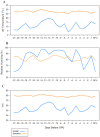Seasonal environmental fluctuations alter the transcriptome dynamics of oocytes and granulosa cells in beef cows
- PMID: 39402580
- PMCID: PMC11479552
- DOI: 10.1186/s13048-024-01530-0
Seasonal environmental fluctuations alter the transcriptome dynamics of oocytes and granulosa cells in beef cows
Abstract
Background: Examining the mechanistic cellular responses to heat stress could aid in addressing the increasing prevalence of decreased fertility due to elevated ambient temperatures. Here, we aimed to study the differential responses of oocytes and granulosa cells to thermal fluctuations due to seasonal differences. Dry beef cows (n = 10) were housed together, synchronized and subjected to a stimulation protocol to induce follicular growth before ovum pick-up (OPU). Two OPU's were conducted (summer and winter) to collect cumulus-oocyte-complexes (COCs) and granulosa cells. In addition, rectal temperatures and circulating blood samples were collected during OPU. Oocytes were separated from the adherent cumulus cells, and granulosa cells were isolated from the collected OPU fluid. RNA was extracted from pools of oocytes and granulosa cells, followed by library preparation and RNA-sequencing. Blood samples were further processed for the isolation of plasma and leukocytes. The transcript abundance of HSP70 and HSP90 in leukocytes was evaluated using RT-qPCR, and plasma cortisol levels were evaluated by immunoassay. Environmental data were collected daily for three weeks before each OPU session. Data were analyzed using MIXED, Glimmix or GENMOD procedures of SAS, according to each variable distribution.
Results: Air temperatures (27.5 °C vs. 11.5 °C), average max air temperatures (33.7 °C vs. 16.9 °C), and temperature-humidity indexes, THI (79.16 vs. 53.39) were shown to contrast significantly comparing both the summer and winter seasons, respectively. Rectal temperatures (Summer: 39.2 ± 0.2 °C; Winter: 38.8 ± 0.2 °C) and leukocyte HSP70 transcript abundance (Summer: 4.18 ± 0.47 arbitrary units; Winter: 2.69 ± 0.66 arbitrary units) were shown to increase in the summer compared to the winter. No visual differences persisted in HSP90 transcript abundance in leukocytes and plasma cortisol concentrations during seasonal changes. Additionally, during the summer, 446 and 940 transcripts were up and downregulated in oocytes, while 1083 and 1126 transcripts were up and downregulated in the corresponding granulosa cells, respectively (Fold Change ≤ -2 or ≥ 2 and FDR ≤ 0.05). Downregulated transcripts in the oocytes were found to be involved in ECM-receptor interaction and focal adhesion pathways, while the upregulated transcripts were involved in protein digestion and absorption, ABC transporters, and oocyte meiosis pathways. Downregulated transcripts in the granulosa cells were shown to be involved in cell adhesion molecules, chemokine signaling, and cytokine-cytokine receptor interaction pathways, while those upregulated transcripts were involved in protein processing and metabolic pathways.
Conclusion: In conclusion, seasonal changes dramatically alter the gene expression profiles of oocytes and granulosa cells in beef cows, which may in part explain the seasonal discrepancies in pregnancy success rates during diverging climatic weather conditions.
Keywords: Beef cows; Granulosa cells; Heat stress; Oocytes; Seasonality; Transcriptome.
© 2024. The Author(s).
Conflict of interest statement
The authors declare no competing interests.
Figures










References
-
- Thornton P, Nelson G, Mayberry D, Herrero M. 2022. Impacts of heat stress on global cattle production during the 21st century: a modelling study. Lancet Planet Health. 2022;6:e192–e201. 10.1016/S2542-5196(22)00002-X - PubMed
-
- Badinga L, Thatcher WW, Diaz T, Drost M, Wolfenson D. Effect of environmental heat stress on follicular development and steroidogenesis in lactating Holstein cows. Theriogenology. 1993;39:797–810. 10.1016/0093-691x(93)90419-6. - PubMed
-
- Roth Z. Effect of heat stress on Reproduction in dairy cows: insights into the Cellular and molecular responses of the oocyte. Annu Rev Anim Biosci. 2017;5:151–70. 10.1146/annurev-animal-022516-022849. - PubMed
MeSH terms
LinkOut - more resources
Full Text Sources
Molecular Biology Databases

